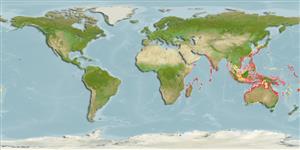>
Acanthuriformes (Surgeonfishes) >
Acanthuridae (Surgeonfishes, tangs, unicornfishes) > Nasinae
Etymology: Naso: Latin, nasus = nose (Ref. 45335).
Eponymy: Captain R W Fagen. We can say no more about him than is contained in James Morrow’s (q.v.) etymology, which states the fish is named after: “…Captain R W Fagen of Miami, Florida, friend and guide on several ichthyological expeditions”. (Ref. 128868), visit book page.
Environment: milieu / climate zone / depth range / distribution range
Ecología
marino asociado a arrecife; rango de profundidad 3 - 35 m (Ref. 9710). Tropical
Distribución
Países | Áreas FAO | Ecosistemas | Ocurrencias, apariciones | Point map | Introducciones | Faunafri
Indo-West Pacific: Kenya south to Bazaruto Islands (Mozambique), Aldabra and Seychelles, and east to the Philippines (Ref. 3145). Reported from southern Japan (Ref. 9710) and Indonesia.
Tamaño / Peso / Age
Maturity: Lm ? range ? - ? cm
Max length : 80.0 cm FL macho / no sexado; (Ref. 9710)
Espinas dorsales (total) : 5; Radios blandos dorsales (total) : 24 - 26; Espinas anales: 2; Radios blandos anales: 23 - 25. Olivaceous grey in color; adults with small dusky spots and large specimens with a short protuberance above upper lip (Ref. 3145). Body ovate and compressed (Ref. 37429).
An uncommon species found in coral and rocky reefs (Ref. 9710). Solitary or in small groups (Ref. 90102).
Life cycle and mating behavior
Madurez | Reproducción | Puesta | Huevos | Fecundidad | Larva
Randall, J.E., 1986. Acanthuridae. p. 811-823. In M.M. Smith and P.C. Heemstra (eds.) Smiths' sea fishes. Springer-Verlag, Berlin. (Ref. 3145)
IUCN Red List Status (Ref. 130435: Version 2024-1)
Threat to humans
Harmless
Human uses
Pesquerías: comercial
Herramientas
Special reports
Download XML
Fuentes de Internet
Estimates based on models
Preferred temperature (Ref.
123201): 24.5 - 28.8, mean 27.5 °C (based on 516 cells).
Phylogenetic diversity index (Ref.
82804): PD
50 = 0.5000 [Uniqueness, from 0.5 = low to 2.0 = high].
Bayesian length-weight: a=0.02089 (0.00974 - 0.04480), b=2.96 (2.78 - 3.14), in cm total length, based on LWR estimates for this Genus-body shape (Ref.
93245).
Nivel trófico (Ref.
69278): 2.2 ±0.1 se; based on size and trophs of closest relatives
Resiliencia (Ref.
120179): Bajo, población duplicada en un tiempo mínimo de 4.5-14 años (Preliminary K or Fecundity.).
Fishing Vulnerability (Ref.
59153): High vulnerability (56 of 100).
Nutrients (Ref.
124155): Calcium = 28.8 [16.8, 56.2] mg/100g; Iron = 0.501 [0.251, 0.878] mg/100g; Protein = 18.7 [17.4, 19.8] %; Omega3 = 0.107 [0.064, 0.205] g/100g; Selenium = 38.2 [19.6, 72.1] μg/100g; VitaminA = 43.6 [12.3, 143.3] μg/100g; Zinc = 1.36 [0.93, 1.98] mg/100g (wet weight);
